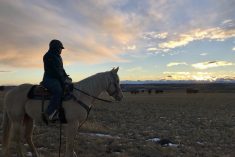With the drought pasture and winter-feed shortage in our area the last two years there are several things worth considering for your cattle this fall. Now, like no other, would be the best time to pregnancycheck and eliminate open cows to save the high cost of stored feed. Depending on your feed source (hay or silage) the cost to over-winter that open cow in our area will be upwards of $400 plus this winter. Cow prices are fluctuating more on a weekly basis than they ever did in the years before BSE when they were high in August, September and January. So holding onto cows to market them in January only costs you more money these days.
Read Also

Reintroducing fire to Saskatchewan pastures
Pastures evolve over time. Woody plants and shrubs, which cattle can’t eat, may encroach on natural grasses. Invasive species, such…
The sooner you can pregnancycheck them off pasture, the more you save. If you are concerned about your setup or the cost of pregnancy-checking, talk to your veterinarian. Many producers who have never had this procedure done are pleased with the speed at which it can be done now, and if you can do all the other fall procedures at the same time the opens, late-breds and culls can be sorted out of the chute so most of the fall work is accomplished in one pass.
Finding one cow open out of 100 pays for the cost of pregnancy checking. Your veterinarian can also identify late-bred cows in case you want to eliminate them or market them in a different way. I like to mark these cows with a paint stick in case the cattle get mixed together again. Most producers keep good records but having them marked makes for easy sorting. Remember to check that cull cows have the RFID tags in them before shipping.
Other procedures can be attended to at fall processing too. No different then when you process calves in the spring, when the cows go through you want to do as many procedures as possible to minimize the amount handling that will be necessary before calving season. If more work needs to be done and labour is an issue we take out one of our technicians to help administer vaccines or an endectocide.
The pour-on endectocides have come down drastically in price in the past few years and it would be foolish not to apply them to control internal and external parasites, especially lice in Western Canada. This price decrease has pretty much brought these products in line with U. S. prices so across-the-border shopping should cease. Plus, with Canadian approved products, the manufacturers will stand behind them should lice outbreaks occur.
This large price drop even has producers talking about getting back to routinely treating at spring turnout with a pour-on. This has been shown to be beneficial to suckling calves, although the verdict will vary on the cows. Consult with your veterinarian to see if this is a wise idea for your herd. We also must be prudent on our usage of these products today to avoid any form of drug-resistant buildup. We also need the dung beetle around to help breakdown those manure patties.
The four-way vaccines that primarily prevent IBR or BVD abortions can be given in the fall but talk to your veterinarian first to see if the killed or live vaccines best fits your program. Before we give live vaccines to a pregnant cow we must establish that good immunity is already present from the prior year. If it’s not, then the killed vaccines are called for and we must ensure all vaccines are given at least yearly. The immune system of the unborn fetus is developing in the last trimester of pregnancy making it even safer vaccinating when preg checking coincides with cattle being further pregnant.
In areas where clostridium (redwater) is present an eight-way blackleg vaccine is given. Even in areas where this disease is not a concern it is best to maintain good immunity by giving the cattle a booster shot every few years. With clostridial organisms being blamed for more and more scours outbreaks having good protection against these organisms in the colostrum can really benefit next year’s calf crop.
With the longer lasting immunity in today’s scour vaccines thanks to new adjuvants (carriers) vaccinating is best done further from calving rather then closer. Most producers are starting to give these products at preg checking time. This also eliminates the need to run heavily pregnant cows through the chute just prior to calving, often during inclement weather. These products have also eliminated the need to revaccinate late calving cows. The heifers, of course, need a booster which can be given four to six weeks later but that is all. With all vaccines remember to handle them properly and protect your investment.
The fall run through the chute is also the time to watch for early cancer eyes, lumpy jaws, lameness and attended to these conditions before they reach a critical stage that will require the animal to be shipped or put down.
Remember to check for the CCIA tags, particularly on any cows that are to be shipped, and have a supply on hand as this is the easiest time to replace lost tags.
Let’s hope winter is short and warm so we can all shave a bit on those feed bills.
—Dr.RoyLewisDVM















